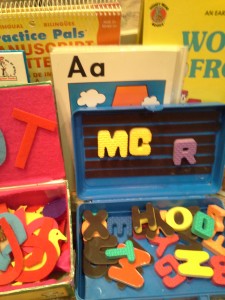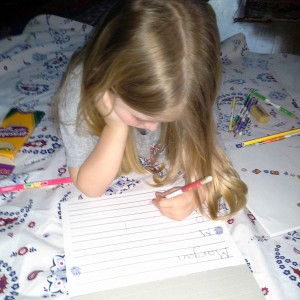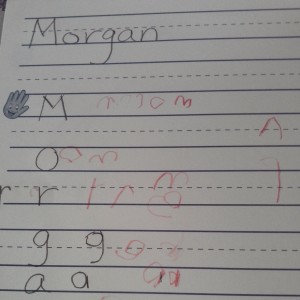
A is for alphabet! I love teaching the alphabet. So will you.
Here are fun, easy to do activities to help your kids learn the alphabet. A reminder that each letter stands for one or more sounds. I suggest you start with the sounds kids feel vibrating in their throats, such as ‘m’. But there are other simple tricks I want to share with you.
This is how I teach the alphabet.
- There are 4 lowercase letters with tails: y, p, q and j.
- There are 4 lowercase letters with sticks: p, b, l, and m.
- There are 4 lowercase letters with circles: o, a, d, and p.
- There are 3 lower case letters with tunnels: h, m, and n.
- There are 3 tall lowercase letters: f, h, and l.
- There are 4 short lowercase letters: a, c, n, and u.
- There are 3 lowercase letters with crossing lines: f, t, and x.
- There are 2 lowercase letters with dots: i, and j.
- There are 4 curving lowercase letters: m, n, e, and f.
- There are 2 slanting lowercase letters: x, and y.
- There are 3 letters whose lowercase and uppercase look about the same: Ss, Xx, Yy.
- All uppercase letters are about the same size, but lowercase letters are different shapes and sizes.
I suggest you teach upper and lower case letters at the same time, to see that an A is the same as a. But you decide what sequence you want to teach and how you want to do it, upper first, or lower.
I like to teach a letter a day, then repeat constantly, looking for letters in all sorts of print, and practice writing the letters. Personally I prefer working in manuscript. Sticks (manuscript printing) better matches the print in early reader books.
Here are some time-tested fun activities, other than You Tube and electronic games. When your child is humming the alphabet song, try these surefire ways to jumpstart your teaching or add to your toolkit.
- Use alphabet flash cards or matching letters with pictures.
- Do lots of alphabet puzzles, with pictures matching letters.
- Find letters using alphabet blocks. Point out and say the letter.
- Practice printing/tracing the letters on mild grade sandpaper, felt, flannel, etc.
- Make letter jackets out of butcher paper or paper bags. Be sure to cut arm and head holes!
- Lima beans alphabet: (cover with clear polish, so they don’t rot).
- Write letters in the air. Write letters using your nose, elbow, or leg, etc.
- Read your favorite alphabet books.
- Use rhythm instruments to hit a note as you say a letter, then find the letter in a book.
- Trace letters in books with Q tips.
- Use a chopstick to point to the letters in books you are reading.
- Prop bag: Fill baggies with small objects starting with the same letter, as an ‘A‘ bag.
- Make alphabet pop-up books out of index cards.
- Make up songs and letter chants for the letters.
- Body letters: Turn your body into a letter, standing up, or laying on the floor.
- Look for letters in books, at the grocery, on street signs, food boxes, etc.
- Create a word (letter wall).
- Make letter books. Also, make letter wallets out of construction paper.
- Jump rope to the alphabet, chanting the letters.
- Body alphabet: bounce a ball for ‘b‘, point to your leg for ‘l‘, walk for ‘w‘, etc.
- Make/use tactile letters: foam letters, alphabet stickers, play dough, shaving cream, magnets on a cookie sheet, wax sticks, pipe cleaners, stampers, sponge painting, finger painting letters, etc.
- Write your own name!
- Use a mirror to help your child form the sound of the letter.
Imagine, only twenty-six letters make thousands of words! Just like people, some letters are short, some tall, some small, like a dot, but each letter is a symbol standing for something. Each letter put with another letter or letters makes syllables, words, then sentences. Isn’t that just amazing! A is for apple, but is in lots of other words, too. So have a great time beginning to learn our wonderful language!
Leaving footprints on your reading hearts,
Rita
Follow me on Twitter and like me on Facebook!



